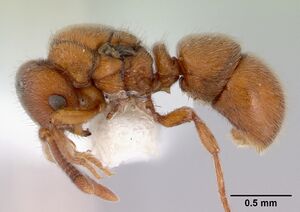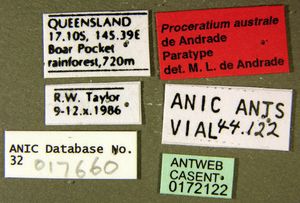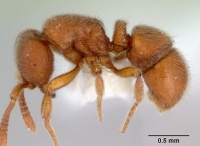Proceratium australe
| Proceratium australe | |
|---|---|

| |
| Scientific classification | |
| Kingdom: | Animalia |
| Phylum: | Arthropoda |
| Class: | Insecta |
| Order: | Hymenoptera |
| Family: | Formicidae |
| Subfamily: | Proceratiinae |
| Tribe: | Proceratiini |
| Genus: | Proceratium |
| Species: | P. australe |
| Binomial name | |
| Proceratium australe De Andrade, 2003 | |
Nothing is known about the biology of Proceratium australe.
Identification
A Proceratium species belonging to the silaceum clade and resembling Proceratium siamense, but differing from it, in the worker, by the narrower petiole and by the hairs of type 2 shorter.
Keys including this Species
Distribution
Australia: Queensland, New South Wales.
Latitudinal Distribution Pattern
Latitudinal Range: -16.18333333° to -34.78333°.
| North Temperate |
North Subtropical |
Tropical | South Subtropical |
South Temperate |
- Source: AntMaps
Distribution based on Regional Taxon Lists
Australasian Region: Australia (type locality).
Distribution based on AntMaps
Distribution based on AntWeb specimens
Check data from AntWeb
Countries Occupied
| Number of countries occupied by this species based on AntWiki Regional Taxon Lists. In general, fewer countries occupied indicates a narrower range, while more countries indicates a more widespread species. |

|
Estimated Abundance
| Relative abundance based on number of AntMaps records per species (this species within the purple bar). Fewer records (to the left) indicates a less abundant/encountered species while more records (to the right) indicates more abundant/encountered species. |

|
Elevation Range
| Species | Elevation (m asl) | |||||
|---|---|---|---|---|---|---|
| 200 | 400 | 600 | 800 | 1000 | 1200 | |
| Proceratium australe | 10-20 | 0-10 | 0-10 | |||
| Shading indicates the bands of elevation where species was recorded. Numbers are the percentage of total samples containing this species. | ||||||
Biology
Castes
Queen
Images from AntWeb
   
| |
| Paratype of Proceratium australe. Queen (alate/dealate). Specimen code casent0172122. Photographer April Nobile, uploaded by California Academy of Sciences. | Owned by ANIC, Canberra, Australia. |
Nomenclature
The following information is derived from Barry Bolton's Online Catalogue of the Ants of the World.
- australe. Proceratium australe De Andrade, in Baroni Urbani & De Andrade, 2003b: 345, fig. 137 (w.q.) AUSTRALIA (Queensland, New South Wales).
- Type-material: holotype worker, 7 paratype workers, 1 paratype queen.
- Type-locality: holotype Australia: Queensland, 17.10S, 145.39E, Boar Pocket, 720 m., 9-12.x.1986, ANIC ANTS VIAL 44.122, rainforest (R.W. Taylor); paratypes with same data.
- Type-depositories: ANIC (holotype); ANIC, MZSP (paratypes).
- Distribution: Australia.
Type Material
- Holotype, worker, Boar Pocket, Queensland, Australia, Australian National Insect Collection.
- Paratype, 7 workers, Boar Pocket, Queensland, Australia, Taylor,R.W., ANIC32-017660, Australian National Insect Collection.
- Paratype, 5 workers, 1 queen, Boar Pocket, Queensland, Australia, Australian National Insect Collection.
- Paratype, 2 workers, Boar Pocket, Queensland, Australia, Museum of Comparative Zoology.
- Paratype, 2 workers, Boar Pocket, Queensland, Australia, Museu de Zoologia da Universidade de Sao Paulo.
Unless otherwise noted the text for the remainder of this section is reported from the publication that includes the original description.
Baroni Urbani and de Andrade (2003) - Proceratium australe is a very variable species. The specimens from Lake Eacham are the most similar to the type series. What we regard as intraspecific variation affects sculptural and structural details listed in the following.
A worker from Tallebudgera Creek has poorly angulate propodeal sides and more superficial sculpture on the mesosoma. A worker from Mt. Kembla and the one from Bruxner Park have more marked postpetiolar sculpture, the erect hairs slightly longer and darker colour. In addition, a worker from Bruxner Park has narrower petiolar node.
A worker from Malanda (Ross & Cavagnaro leg.) has more superficial postpetiolar sculpture, subangulate propodeal sides and narrower petiolar node. A worker from Malanda collected by Brown also has more or less shining sculpture and propodeal sides with the most obtuse trace of angulation according to Brown (1958a).
Workers from Lamington and Roy National Parks are slightly larger (TL ≥ 3.26 mm instead of 2.57-3.09 mm).
Gynes from Barry and from Cooloola have small eyes (EL 0.14-0.15 mm instead of 0.19-0.21 mm). A gyne from Landsborough is larger than the other gynes examined (TL 3.75 mm instead of 3.14-3.61 mm). A gyne from Landsborough has higher CI (98.6 as opposed to 93.8-95.8). A gyne from Cooper Creek has very superficial postpetiolar sculpture.
Based on the material available for the present study we prefer to adopt the conservative position of considering all these specimens as belonging to a single, variable species.
Description
Worker
Head slightly longer than broad and with the sides gently diverging posteriorly. Vertex in full face view almost straight. Clypeus reduced and as long as the antennal sockets. Anterior border of the clypeus truncate. Frontal carinae not very far from each other, slightly covering the antennal insertions. Lateral expansions of the frontal carinae not very narrow, little raised, strongly diverging on the two anterior fourths, converging on the third fourth, subparallel and carinate only on the last fourth. Frontal area gently concave on the three anterior fourths and with a central longitudinal carina starting from the last fourth and prolonging posteriorly. Head anterolaterally with a thick, short, longitudinal carina. Genal carinae marked, each carina corresponding to the external border of a deep sulcus. Eyes visible as a dark dot below the integument, small and on the middle of the head sides. First funicular joint about as long as broad. Funicular joints 2-10 broader than long. Last funicular joint as long as the sum of joints 6-10. Scapes short of the vertexal margin and gently thickening apically. Masticatory margin of the mandibles with 7-8 denticles before the pointed apical tooth. Palp formula 2,2.
Mesosoma gently convex and about as long as the maximum head length (mandibles included) in profile. Pronotal and propodeal sutures absent. Basal face of the propodeum declivous posteriorly. Declivous face of the propodeum flat. Area between the basal and declivous faces of the propodeum weakly concave, dorsally carinate and laterally angulate. Sides of the declivous face of the propodeurn carinate. Propodeal spiracle round and above mid height in lateral view.
Petiole subrectangular and not very narrow; its anterior border straight and anterolaterally carinate. Ventral process of the petiole spine-like and directed backwards. Postpetiolar sternite anteromedially with a marked subtriangular projection, gently convex posteriorly in side view. Constriction between postpetiole and gaster impressed. Gastral tergite I about 1/3 longer than the postpetiole and convex on the curvature. Posterior border of the gastral tergite I thick and irregular. Remaining gastral tergites and sternites curved ventrally.
Legs not very short. All tibiae with a pectinate spur. Spurs of fore legs without basal spine. Fore basitarsi longer than the mid ones. Hind basitarsi about 1/4 shorter than hind tibiae. Second tarsoinere of hind legs about as long as the pretarsus. Pretarsal claws simple. Arolia absent.
Sculpture. Anterior half of the head and head sides with dense piligerous foveae mixed with irregular rugosities. Posterior half of the head dorsum, mesosoma, petiole and postpetiole densely punctate and with very sparse, short, irregular, rugosities, the punctures more superficial on the anterior half of the mesosoma. In addition the propodeal dorsum, petiole and postpetiole with sparse granulation. Caster smooth and with minutely piligerous punctures denser and larger on the sides. Legs punctate.
Body covered by hairs of three main types: (1) short, dense, subdecumbent on the whole body, suberect and sparse on the funicular joints; (2) longer than type (1), erect on the whole body, slightly shorter on the scapes, absent on the funiculi (3) shorter than hair type (1), dense and decumbent on the funicular joints only. In addition the funicular joints bear whitish, thick, appressed, sparse hairs.
Colour. Light ferrugineous with lighter antennae and legs.
Measurements in mm and Indices: TL 2.56-3.44; HL 0.60-0.77; HW 0.54-0.73; EL 0.03-0.04; SL 0.39-0.51; WL 0.69-0.97; PeL 0.18-0.23; PeW 0.27-0.34; HFeL 0.41-0.58; HTiL 0.34-0.46; HBaL 0.26-0.36; LS4 0.28-0.36; LT4 0.55-0.72; CI 90.0-95.8; SI 63.9-68.7; IGR 0.48-0.52.
Queen
Differing from the worker in the following details: eyes large, slightly less than 1/3 of the head length, colnposed by many facets and with ocular pilosity. Ocelli well developed.
Mesosoma robust and convex in side view. Parapsidal furrows marked. Scutellum with the sides gently converging posteriorly and with the posterior border subtruncate. Dorsum of the scutellum with a thick longitudinal carina. Metanotum with a small tooth. Basal face of the propodeum medially concave. Area between the basal and declivous faces of the propodeum carinate and subangulate on each side.
Measurements in mm and Indices: TL 3.14-3.75; HL 0.65-0.74; HW 0.61-0.73; EL 0.14-0.21; SL 0.43-0.51; WL 0.94-1.10; PeL 0.22-0.23; PeW 0.33-0.37; HFeL 0.52-0.61; HTiL 0.42-0.49; HBaL 0.33-0.39; LS4 0.34-0.44; LT4 0.68-0.90; CI 93.8-98.6; SI 65.7-68.9; IGR 0.47-0.50.
Type Material
Holotype worker from Australia labeled: "Queensland, 17.10S, 145.39E, Boar Pocket, rainforest, 720m, R. W. Taylor, 9-12.X.1986, ANIC ANTS VIAL 44.122"; seven paratype workers and one paratype gyne, same data as the holotype; holotype worker, 5 paratype workers and 1 paratype gyne, in Australian National Insect Collection, 2 paratype workers in Museu de Zoologia da Universidade de Sao Paulo.
Etymology
"Australe" is a neologism indicating the provenance from Australia.
References
- Baroni Urbani, C., de Andrade, M.L. 2003. The ant genus Proceratium in the extant and fossil record (Hymenoptera: Formicidae). Museo Regionale di Scienze Naturali, Monografie, 36, 1–492. (page 345, fig. 137 worker, queen described)
- Burwell, C.J., Nakamura, A. 2020. Rainforest ants (Hymenoptera: Formicidae) along an elevational gradient at Eungella in the Clarke Range, Central Queensland coast, Australia. Proceedings of the Royal Society of Queensland 125: 43-63.
References based on Global Ant Biodiversity Informatics
- Baroni Urbani C., and M.L de Andrade. 2003. The ant genus Proceratium in the extant and fossil record (Hymenoptera: Formicidae). Museo Regionale di Scienze Naturali, Monografie 36: 1-480.
- Scott-Santos, C.P., F.A. Esteves, C.R.F. Brandao. 2008. Catalogue of "Poneromorph" ant type specimens (Hymenoptera, Formicidae) deposited in the Museu de Zoologia da Universidade de Sao Paulo, Brazil. Papeis Avulsos de Zoologia 48(11):75-88.


